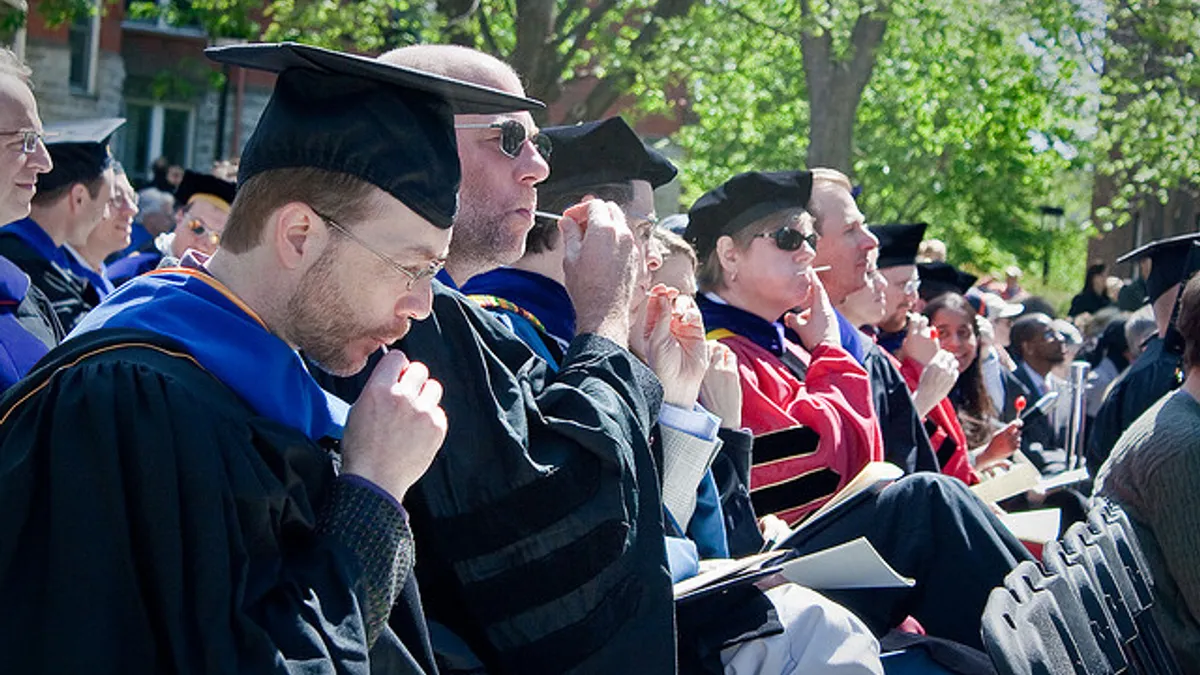If 60 full-time faculty members each retained one additional student per course who would have otherwise dropped out, the college could stand to gain an additional $1.6 million per year in revenue.
Wallace Community College Dean of Instruction Tony Holland used these numbers in his presentation during the American Association of Community Colleges meeting this week in New Orleans to illustrate the need for institutions to focus more heavily on professional development of faculty as a direct impact on the bottom line.
A recurring theme across several sessions at the AACC meeting was the idea that professors are hired to teach, but few are ever taught how to do so. Presenters attempted to tackle this theme from a number of different angles.
“When you’re constantly adding new concepts and ideas, you’re also weeding out archaic ideas,” Holland said.
And regarding the concern that a huge investment in faculty development would lead to an exodus of faculty from the college to leadership positions at other institutions, he said, “It is better for us to train them and lose them than not train them and keep them.”
“We need to prepare our faculty to prepare our students to do that other stuff [in the mission statement] that we’ve spent all that time working through,” said Jennifer Lanter, Dean General Studies Moraine Park Technical College in Fond du Lac, WI.
Where to start, then? To Holland, “professional development has to be relentlessly focused on student success.”
Peer learning is particularly engaging and helpful. For example, at Wallace, Holland and his team circulate weekly spotlights on faculty members who are getting a particular thing right. The spotlights consist of the faculty member, department chair, dean, associate dean and instructional dean all adding their own short narratives about this person’s approach. They’re sent out to the entire staff, and Holland says this has been tremendously effective.
Lanter, who was director of a program at the University of Wisconsin-Green Bay prior to joining the staff at Moraine Park Technical College, established a fellowship program for staff at her institution centered on providing dedicated time for faculty to “come together to gain knowledge related to learner-centered teaching approaches” and “foster innovative teaching practices in a collaborative environment.”
Not only does her program provide dedicated time (and a small stipend) for professors to collaborate in a dedicated space, it also includes a peer observation component, in which professors from different disciplines are able to observe techniques used to engage students across a wide range of material.
“How often do faculty members really get a chance to sit into other faculty members’ classrooms? Not often,” she said, noting the experience was reported as very beneficial by participating faculty.
PD is not just for full-timers
With more than half of all faculty members in higher ed contingent or part-time faculty — at community colleges, they account for 70% of the workforce and teach 58% of the courses nationwide — it is important to ensure any professional development plans also include this huge sector of the professorial population.
Jessica Howard, president of Portland Community College’s Southeast Campus, said during her session at the AACC meeting, “recent data suggests that the part-time teaching model is really not engaging students or serving them well.”
Howard pointed to data that suggests students tend to be significantly less likely to transfer as their exposure to part-time faculty is increased, which she said is consistent with persistence data at the four-year level, and also the fact that the majority of developmental or remedial courses nationwide are often "more heavily reliant on part-time faculty than other disciplines."
“Part-time faculty are most likely to teach the students who need the most help,” she said.
And this is largely because, in addition to a lack of access to office space or technology and resources on campus, there is generally “a lack of orientation/professional development” for part-time faculty, Howard said.
“It’s a transactional arrangement, with little in and out — you show up, you teach a class, and you get a notably small amount of money for it. That’s the exchange. So how do you make the case that you should be using more” of your own time and resources to invest more into student teaching and learning, asked Howard, who herself started out her career as an adjunct.
“Part-time faculty are much less likely to use high-impact teaching practices, like referrals to academic and support services, academic advising, team teaching,” because of the limited amount of time they spend on, and lack of familiarity with, campus.
“It’s not good for the part-time faculty member, it’s not good for the student, and I would argue it’s not that good for the full-time faculty member either, because it means … all those things [like mentorship, club advisement, academic advisement and other service-oriented activities on campus] become the responsibility of a smaller and smaller few,” Howard said.
Valencia College East & Winter Park Campuses President Stacey Johnson said at her institution, part-time faculty members are required to go through a six-week hybrid course, “Teaching in our learning college,” which comes with 30 professional development hours and teaches faculty how to teach in learning-centered environment.
She said because of this investment in adjuncts, a majority of the college’s full-time hires are actually pulled from the part-time ranks, since most are already indoctrinated on the way the college works and how to help students become successful.
Buy-in starts at the top
But before targeting the professoriate with new changes, Holland said, leadership must fully embrace and promote a culture of student success. “Is it evident every time you send an email that you’re passionate about student success and student achievement?” he asked. “Leaders’ commitment has to be higher than your team members’. So does your dedication.”
“It’s much more about mindset than it is about skillset,” Holland said. “It’s true in teaching, and it’s much more true in leadership.”
















